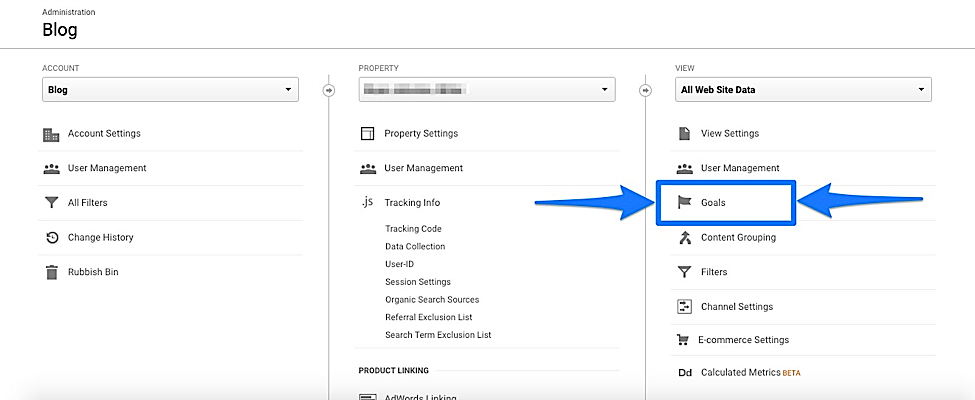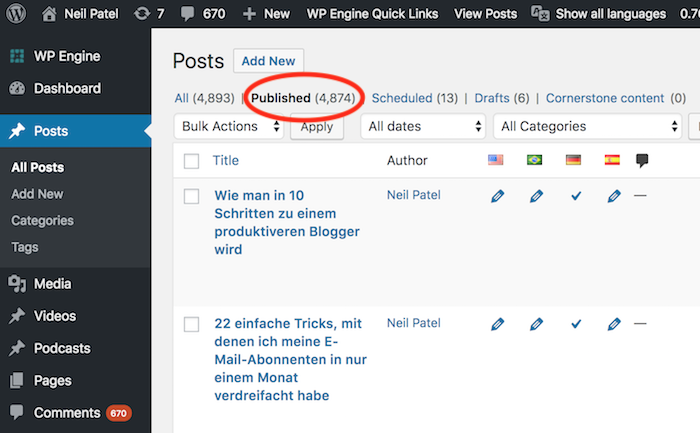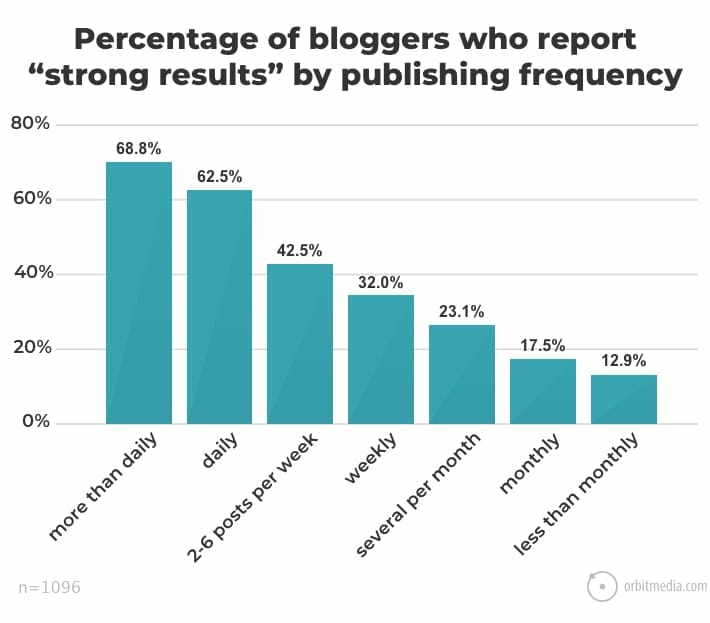It’s no secret that publishing quality content on a regular basis is one of the best ways to generate leads. But what does “regular basis” actually mean?
For some companies, a schedule of one blog post per month meets that criteria, while others crank out several every day. Most lie somewhere in between, posting weekly, a few times each week, or – if they’re really ambitious – daily.
So what’s the right frequency for your company? The answer is…there isn’t one answer. Sorry to disappoint you, but the posting schedule that’s right for you may be totally different than what works for another brand.
Determining the right blogging volume for your business comes down to a number of different factors, including your specific goals, resources and content promotion plans. The good news, however, is that once you’ve taken each of these factors into consideration, you’ll find it much easier to build a solid content marketing strategy that meets your needs.
Define Your Content Goals
Let’s be clear.
Content creation isn’t a goal in itself. It’s a means of achieving a goal. Share on XYou can decide to publish three blog posts every week, but you don’t actually have an effective content marketing strategy if you don’t know why that schedule makes sense.
Whether you’re looking for more traffic, social media growth, Google rankings for specific keywords or quality leads, you need to clearly define not just what you want your content to accomplish, but what your metrics for success are.
Let’s say your goal is to double your monthly unique visitors in three months – and let’s assume that the majority of your website traffic currently comes from ten existing blog posts.

To double your traffic, you’ll need ten more popular blog posts. But since every blog post probably won’t be a slam dunk, you may want to produce 15 or 20. And to give yourself enough time to get ranked and build adequate promotion into your schedule, you’ll want to push them out in month one. Is that doable? If not, revise your goal to one that is.
Right now, my goal for Single Grain is improving our rankings for specific keywords and to doubling our unique visits. To accomplish that, we’re creating as much content as we can around the keywords we’ve defined as being important to our business.
Once we hit these metrics, we’ll shift our strategy to support new goals, likely decreasing our posting frequency to support more long-form, in-depth blog posts.
Dive Deeper:
- How to Build a High-Performance Content Marketing Strategy
- How To Measure Your Content Marketing ROI With Google Analytics
- Creating Google Analytics Funnels and Goals: A Step-by-Step Guide
- 9 Mission-Critical Lead Generation Metrics You Need To Track
- The Content Marketer’s Guide to Keyword Research
Consider Your Resources
How much can you realistically blog? Answering that question is important. You may want to publish new content every day, but if you only have the time, resources and budget to create one post per week or every other week, it’s much better to stick to that frequency.
Currently, we publish around six new blog posts each week on the Single Grain blog:

We don’t have the time to write and produce that much in-house, so we do what we can (which usually ends up being around three posts per week) and supplement our blog with guest articles. It’s a lot of content, but it’s doable for us. Your potential output might look very different, and that’s okay.
It’s important to remember that, just because you invest a lot of resources into content creation now, that doesn’t mean you’ll have to do it that way forever. Content creation pays out over time.
An initial investment in quality content is like royalties after you write a song: the rewards keep coming in as people discover your content while searching for relevant keywords. Share on XPerform a Content Audit
How much content do you already have and, more importantly, how good is it? If you already have a repository of long-form, highly trafficked blog posts, then you probably don’t need to publish something new every day.
HubSpot studied the impact of total blog posts on inbound traffic, and determined that a tipping point happened somewhere around 400 posts. In fact, companies that had published 401+ blog posts in total got about twice as much traffic as companies that published 301-400 blog posts.
It may take you a while to get to 401 blog posts, but it might not be necessary, either. Consider Brian Dean of Backlinko. He has fewer than 75 blog posts, but they bring in a ton of search traffic. Why? Because he’s always keeping the posts updated with relevant information, and Google doesn’t just rank content for newness – freshness is an important factor as well.
Refreshing your already-published posts is just as important as creating new ones. If you have an old blog post that’s still a lead generator for you, make sure that none of the links or information is out-of-date. Add new sections to make it more comprehensive. If you have three short pieces on the same topic, combine them to create a thorough guide on that subject. You don’t have to start from scratch.
Contrary to popular belief, there is such a thing as too much content. Neil Patel has a blog post called Less Is More: Why I Wish I Never Wrote 4,784 Blog Posts in which he reflects on how the majority of the content he wrote and acquired didn’t increase his traffic significantly, and how he regrets not being more strategic about blogging:

If you don’t have any content – or if what you do have isn’t doing anything for you, traffic-wise – then you might want to consider ramping up blogging until you start to see results.
Dive Deeper: The Step-by-Step Guide to Conducting a Content Audit
Tailor Content to Your Audience & Platform
Your primary source of traffic will help determine how much you should be posting, as well as what type of content you should focus on.
- Social media: If you’re promoting your posts on social media and that’s driving traffic and leads for you, it might be worth experimenting with cranking out the shorter content types that tend to perform better on platforms like Facebook and Twitter (such as listicles and how-to articles). Timely content is also good for social media, because you can jump onto hashtags and trending topics. If you opt for this strategy, you’ll probably need to invest in creating several pieces per week to keep engagement up.
- Search: If most of your traffic comes from search, then longer, more in-depth and more journalistic pieces should be your focus. The average Google first page result contains 1,890 words. Articles reaching this length take longer to produce, so you might only publish once every week or even once every two weeks, whatever it takes to produce quality content.
- Emails: Your email subscribers are often your most engaged users, so measuring what pieces of content they respond to is vital. Is it the shorter, more current pieces, or the longer, more in-depth ones? Is it something in between or content on specific topics? Playing around with email frequency and measuring any changes in response rates will also give you a good idea of how often your audience wants something new.
Of course, there are plenty of other ways to get your content out there, and you’ll want to keep them in mind when you start writing. For example, I have a friend, Paul Orlando, who is the Incubator Director and Adjunct Professor of Entrepreneurship at the University of Southern California. A while back, Paul started a blog called Unintended Consequences about second-order effects – basically, what happens after a decision is made.
He started writing one long-form post each month and sharing it to Hacker News, a community where people in tech go to share content. They’re very critical and will eat you alive if they don’t like your content. But because his content is good, his blog posts are doing well, and it’s generating a lot of traffic and subscribers for him.
If you have the resources to create a content marketing strategy that encompasses all of the above audiences, then you absolutely should do that. If you don’t, be like Paul. Pick one, do it well and expand later.
Dive Deeper:
- Beyond the Newsletter: You’ve Got Their Email, Now What?
- Email Marketing Myths & Truths: How to Enhance Your Email Marketing Strategy
- Do You Really Need to Write 1,890-Word Blog Posts to Rank on Page 1?
- The Beginner’s Guide to Crafting a Highly Effective Social Media Strategy in 2019
Take a Look at What’s Going on in Your Industry
Blogging is a competitive sport. If you’re a digital marketing agency and you want to create a guide to SEO in 2019, guess what? Everyone else is doing the same thing. Or they’ve already done it. If you want to stand out, you need to add value, maybe by:
- Sharing personal experiences
- Creating client case studies
- Performing original research and using your own statistics
In a competitive industry, you’ll probably want to publish less, but focus more on the long-form, data-heavy, well-researched pieces that are going to take your content to the top of the search results.
If you work in an industry where your competitors aren’t posting a lot of content, you have a huge opportunity – and probably not much time to seize it. Crank out as much content, long or short, as you can, as quickly as possible, before everyone else realizes they need to be doing it, too.
Craft content for all of your relevant keywords. Once you’re getting all the search traffic you can, scale back on posting and start focusing on quality over quantity.
Dive Deeper:
- 9 Effective SEO Techniques to Drive Organic Traffic in 2019
- How To Write Data Driven Posts
- 4 Ways to Signal to Google that You’re an Expert Content Creator
- 30 Ways to Come Up with Great Ideas for Your Blog Posts
Test Your Content Schedule (And Keep Testing)
You know that marketing is all about testing to see what works, revising, testing again, and so on. Try posting one blog post one week, and three another week. If you get a significant traffic bump, try five. If you don’t, then try four. Keep at it until you find your magic number.
If that magic number is three and you only have the resources for one each week, then do one. Just make sure that blog post is aligned with your goals and strategy. According to an Orbit Media study, bloggers who publish weekly or more are nearly 2.5x more likely to report strong results than bloggers who publish monthly or less:

You don’t have to be a blogging machine to reap the rewards. Many businesses don’t even have a blog, but as long as you’re being strategic and consistent, you’ll see growth. If your business is new or you don’t yet have a lot of traffic, start slowly and build up – understanding that it can be hard to really measure success until you get some traction.
Over time, your content goals and/or available resources will likely shift, and you’ll have to repeat this testing process all over again. Don’t get frustrated. Neil and I regularly look to signals like this as great opportunities to analyze your past successes and use them to inform your future strategy.
The Truth About Blogging Frequency
Plenty of articles have been written about the best blog posting frequency. Many of them rank well in Google and get shared on social media. But the truth is, there isn’t a one-size-fits-all approach.
So many different factors go into what creates a “successful” blog post, but even the metrics for defining success vary from person to person and business to business. Finding the approach that’s right for you takes work. But if you set aside the time to plan content strategically, your business will reap the benefits – and not just when you hit “publish,” but for months and even years to come.







